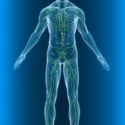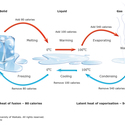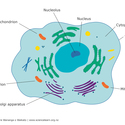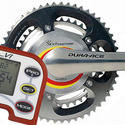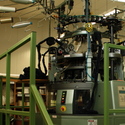‘Nano’ means small, right? Sort of. To scientists, ‘nano’ doesn’t just mean small. It means almost unimaginably small. A nanometre1 (nm) is a billionth of a metre2, so when scientists refer to things as nano, they are talking about things a few billionths of a metre in size.
Nanoscience3 or nanotechnology4 means the study of chemical and physical changes that happen at the nanoscale5. By nanoscale, we mean in the region of 1–100 nm, where properties of substances differ from those at a larger scale. Nanotechnology makes use of these nanoscale properties to develop new materials and devices.
Nature of science
Nanotechnology is often seen as a trendy new science that will change our future. It is new, in the sense that new techniques and instruments are used, and new materials and devices are developed, but it is based on knowledge gained over many years, in many fields of science.
The word ‘nano’ originally meant ‘dwarf’, and it has been around a long time. Sometimes people have used ‘nano’ to label something small. In 1877, a dinosaur only a metre long was named Nanosaurus.
Nanotechnology new and old
The idea of nanotechnology started in the 1950s, though the name wasn’t invented until 1974. In a way, though, nanotechnology has been around for centuries. After all, a lot of chemistry is about controlling nanoscale objects – atoms and molecules6 – and since ancient times, artists have used the special properties of gold7 and other metal8 nanoparticles to colour glass, but without knowing about ‘nanoparticles’.
What makes nanotechnology new is the way that scientists and engineers are learning to see, understand, measure and manipulate matter9 at the nanoscale.
Early pioneers of nanotechnology saw a world where everybody would have a personal machine that could assemble anything they wanted, atom10 by atom. No more growing food, no more factories – no more work! Nanoscale, self-replicating robots would keep our bodies healthy and long-lived. The whole structure of society would change.
Many scientists believe that this vision of a future based on nanotechnology will never happen, not only because they think the technology dreamed about is impossible, but because society won’t let it happen. But some changes are already taking place. Instruments have been invented that let us see and manipulate atoms. Nanotechnology products are all around us.
You can already buy sunscreens and skin creams based on nanoparticles, new paints, stain-repellent clothes, and many other things. Nanotechnology is helping us switch11 from non-renewable fuels to fuel12 cells and solar power13. There are smart materials like new computer screens and self-tinting windows. An iPod makes use of nanotechnology to store and read huge amounts of data14.
Nanotechnology is also creating new problems, and causing scientists to think of new ways of doing things. The components of computers are now becoming so small that they have different properties to larger components. This means that the computers of the future need to be reinvented.
The future of nanotechnology
Imagine thousands of tiny man-made bits of silicon15 injected into your body. They’re only a few billionths of a metre across. They track down cancer16 cells and kill them with drugs they are carrying. You can see where the nanoparticles are because they give off coloured light. Far fetched? You may think so, but scientists in Wellington are already well on the way to making it real.
All over the world, nanotechnologists are developing materials and devices that have the potential to change our lives. Nanoscale pumps, switches and motors exist, but the tiny, self-replicating machines seen by nanotechnology pioneers are a long way off, if they happen at all. But we know they work. After all, the DNA17 of living organisms is a successful nanoscale, self-replicating molecular machine that builds up structures molecule18 by molecule. And life depends on it.
Key terms
For explanations of key concepts, see Nanoscience – key terms.
- nanometre: Nanometre (nm) is a billionth of a metre.
- metre: The base unit of length in the International System of Units (SI).
- nanoscience: The study of atoms, molecules and objects whose size is on the nanometre scale (1–100 nanometres).
- nanotechnology: Understanding and working with matter at the scale of atoms and molecules. 1 nanometre is a millionth of a millimetre.
- nanoscale: Refers to dimensions below 100 nm. Also refers to the small size, often only a few nm, at which the properties of a substance are different to properties of bulk material.
- molecule: Two or more atoms bonded together. The molecule of an element has all its atoms the same. The molecule of a compound has two or more different atoms.
- gold: A transition metal in Group 11 of the periodic table – symbol Au, atomic number 79.
- metal: Any of a category of elements that usually have a shiny surface, are generally good conductors of heat and electricity and can be melted or fused, hammered into thin sheets or drawn into wires (for example, copper).
- matter: The basic structural component of all things that have mass and volume.
- atom: The smallest possible unit of matter that still maintains an element’s identity during chemical reactions. Atoms contain one or more protons and neutrons (except hydrogen (H), which normally contains no neutrons) in a nucleus around which one or more electrons move.
- switch: An electrical component that can make or break an electrical circuit, connecting or interrupting the current or diverting it from one conductor to another.
- fuel: 1. A combustible substance that provides energy. 2. A body fuel such as fat, carbohydrates and protein that supplies energy for animals’ activities.
- solar power: The energy received by the Earth from the Sun. Also called solar energy.
- data: The unprocessed information we analyse to gain knowledge.
- silicon: A semimetal – symbol Si, atomic number 14.
- cancer: The term for a group of more than 100 diseases in which abnormal cells divide and multiply uncontrollably.
- DNA: Deoxyribonucleic acid (DNA) is a molecule that contains the instructions needed for an organism to develop and function. These instructions are stored as a code made up of four chemical bases: adenine (A), guanine (G), cytosine (C) and thymine (T).
- molecule: Two or more atoms bonded together. The molecule of an element has all its atoms the same. The molecule of a compound has two or more different atoms.


